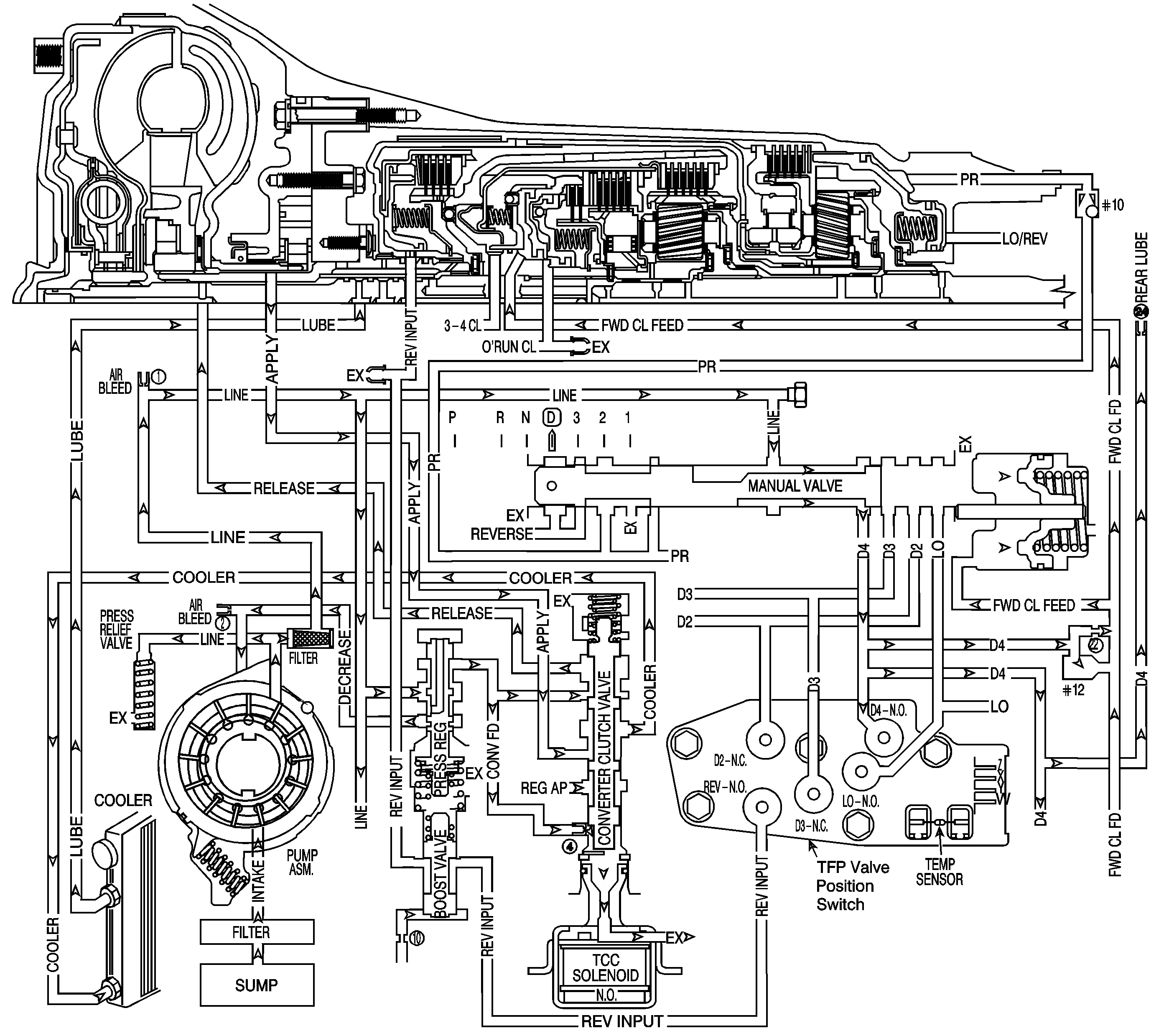
Circuit Description
The flow of transmission fluid starts in the bottom pan and is drawn through the filter, control valve body assembly, transmission case and into the oil pump assembly. The oil pump assembly pressurizes the fluid and directs it to the pressure regulator valve where it becomes the main supply of fluid to the various components and hydraulic circuits in the transmission. Hot fluid exiting the torque converter flows through the converter clutch apply valve and into the transmission cooler lines to the oil cooler located in the vehicle radiator, and auxiliary cooler if equipped. From the cooler, fluid returns to cool and lubricate the front of the transmission. In forward drive ranges, D4 fluid from the manual valve is routed through an orificed cup plug in the rear of the transmission case to feed the rear lube fluid circuit.
When the powertrain control module (PCM) detects a high transmission fluid temperature (TFT) for a long period of time, then DTC P0218 sets. DTC P0218 is a type C DTC.
Conditions for Running the DTC
| • | No TFT sensor DTCs P0711, P0712 or P0713. |
| • | The ignition switch is ON for 5 seconds. |
Conditions for Setting the DTC
The TFT is greater than 130°C (266°F) for 600 seconds (10 minutes).
Action Taken When the DTC Sets
| • | The PCM does not illuminate the malfunction indicator lamp (MIL). |
| • | HIGH TRANS TEMP message displays on the driver information center (DIC). |
| • | The PCM freezes transmission adapt functions. |
| • | The PCM records the operating conditions when the Conditions for Setting the DTC are met. The PCM stores this information as Failure Records. |
| • | The PCM stores DTC P0218 in PCM history. |
Conditions for Clearing the DIC/DTC
| • | The PCM clears the DIC message when the condition no longer exits. |
| • | A scan tool can clear the DTC. |
| • | The PCM clears the DTC from PCM history if the vehicle completes 40 warm-up cycles without a non-emission-related diagnostic fault occurring. |
| • | The PCM cancels the DTC default actions when the fault no longer exists and/or the ignition switch is OFF long enough in order to power down the PCM. |
Diagnostic Aids
| • | The scan tool Trans. Fluid Temp. should rise steadily to a normal operating temperature, then stabilize. |
| • | Ask about the customer's driving habits, trailer towing, etc. Trailer towing should occur in D3. |
| • | Refer to Symptoms - Automatic Transmission . |
Test Description
The numbers below refer to the step numbers on the diagnostic table.
Step | Action | Value(s) | Yes | No | ||||||
|---|---|---|---|---|---|---|---|---|---|---|
1 | Did you perform the Powertrain Diagnostic System Check? | -- | Go to Step 2 | Go to Diagnostic System Check - Engine Controls in Engine Controls | ||||||
2 |
Important: Before clearing the DTC, use the scan tool in order to record the Failure Records. Using the Clear Info function erases the Failure Records from the PCM. Refer to Transmission Fluid Check . Did you perform the fluid checking procedure? | -- | Go to Step 3 | Go to Transmission Fluid Check | ||||||
Did you find and correct the condition? | -- | Go to Step 6 | Go to Step 4 | |||||||
4 | Test for correct line pressure. Refer to Line Pressure Check . Did you find and correct the condition? | -- | Go to Step 6 | Go to Step 5 | ||||||
5 | Test the torque converter stator. Refer to Torque Converter Diagnosis . Did you find and correct the condition? | -- | Go to Step 6 | Go to Intermittent Conditions in Engine Controls | ||||||
6 | Perform the following procedure in order to verify the repair:
Has the test run and passed? | -- | System OK | Go to Step 1 |
